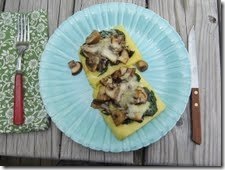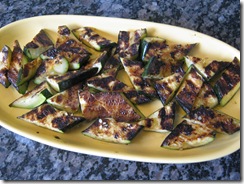By Jude Waterston
 As anyone who has traveled to Italy knows, a classic mid-day Italian meal is an affair, and a leisurely, lengthy one at that. It consists of a variety of courses, and the quantity of the dishes, and the pace, become reasons to socialize. To whet the appetite, and not even considered one of the traditional courses, is the antipasti. This appetizer might consist of a few nearly transparent slices of prosciutto di Parma wrapped around a wedge of juicy melon; or crostini (toasted baguette slices); or grilled polenta topped with chicken liver pate or sautéed wild mushrooms. The first course, primo piatto (or simply primo) may be a pasta (perhaps served in a delicate broth), risotto, polenta, gnocchi or soup.
As anyone who has traveled to Italy knows, a classic mid-day Italian meal is an affair, and a leisurely, lengthy one at that. It consists of a variety of courses, and the quantity of the dishes, and the pace, become reasons to socialize. To whet the appetite, and not even considered one of the traditional courses, is the antipasti. This appetizer might consist of a few nearly transparent slices of prosciutto di Parma wrapped around a wedge of juicy melon; or crostini (toasted baguette slices); or grilled polenta topped with chicken liver pate or sautéed wild mushrooms. The first course, primo piatto (or simply primo) may be a pasta (perhaps served in a delicate broth), risotto, polenta, gnocchi or soup.  The second or main course, secondo piatto, consists of seafood, meat, poultry or game. Alongside the main course, contorno (vegetable side dishes) are served. After the vegetable dishes are cleared, and the second course completed, a bitter salad of radicchio and field greens cleanses the palate, or a formaggio (cheese) course may follow. Finally, fresh fruit, often steeped in wine, dolce (cake or cookies), espresso, and maybe even a digestivo such as grappa or brandy round out the meal. Food is not taken lightly
The second or main course, secondo piatto, consists of seafood, meat, poultry or game. Alongside the main course, contorno (vegetable side dishes) are served. After the vegetable dishes are cleared, and the second course completed, a bitter salad of radicchio and field greens cleanses the palate, or a formaggio (cheese) course may follow. Finally, fresh fruit, often steeped in wine, dolce (cake or cookies), espresso, and maybe even a digestivo such as grappa or brandy round out the meal. Food is not taken lightly  in Italy, nor is the afternoon nap.
in Italy, nor is the afternoon nap.
The vast array of contorni, prepared in various guises and utilizing many different cooking methods, is what interests me. The most important aspect to turning out flavorful contorni, and this cannot be emphasized enough, is to follow the seasons, and for each there are many choices. Artichokes, fava beans, spinach, asparagus and peas are some of the springtime contenders. Summer’s sweet bell peppers in bright shades of orange, yellow, and red or eggplants, zucchini, and tomatoes are good warm weather choices. Autumn provides wild mushrooms, cauliflower, broccoli, fennel, and many kinds of squash. In winter, there is an abundance of root vegetables, such as turnips, parsnips, potatoes, and carrots to play with.
 Italians employ a panoply of methods for cooking their vegetables. Stuffed baked zucchini and eggplants are popular, as are just about any vegetable gratinato, gratineed. Chunks of vegetables can be dipped in a pastella, or light batter, and deep fried. These are usually served with nothing more than a lemon wedge to squeeze over the hot, crisp fritter. Vegetables are often simply saltate, sautéed, or they can be stufate, stewed, or brasate, braised.
Italians employ a panoply of methods for cooking their vegetables. Stuffed baked zucchini and eggplants are popular, as are just about any vegetable gratinato, gratineed. Chunks of vegetables can be dipped in a pastella, or light batter, and deep fried. These are usually served with nothing more than a lemon wedge to squeeze over the hot, crisp fritter. Vegetables are often simply saltate, sautéed, or they can be stufate, stewed, or brasate, braised.
Another contorni, which would serve as an ideal brunch or light dinner option is a strata – a casserole of layered bread, vegetables, and cheese that is steeped in an egg and milk bath for hours before being baked. The result, similar to a bread pudding, is a custardy, savory mélange that melts in the mouth and is deeply satisfying.
Now that spring is upon us, the farmers market beckons. As each vegetable makes its first appearance, from ramps to asparagus, I employ it. Recently, sliced sautéed oniony ramps and mushrooms in a light sherry cream sauce made for a delicious pasta sauce, and oven-roasted asparagus topped with grated lemon rind and Parmigiano-Reggiano were a perfect accompaniment to grilled pork chops. I found some beautiful spinach during my last foray at the farmers market and decided to make a strata, along with a brightly dressed salad for lunch. Any dark, leafy green, such as kale or Swiss chard, can be substituted for the spinach. Or use a bunch of the fantastic asparagus available now. Experiment, invent, be creative with contorni.
Spinach, Mushroom, and Cheese Strata
Serves 6
1 ounce dried porcini mushrooms
½ pound fresh spinach
1 small red onion, finely chopped
1 ½ cups grated Gruyere cheese
3 tablespoons unsalted butter
1 ½ cups half & half
5 large eggs
1 tablespoon Dijon mustard
1/8 teaspoon ground nutmeg
Salt and freshly ground pepper
6 – ½” thick slices Focaccia bread (or use firm, best-quality white sandwich bread, brioche, or challah, cut into 2 – 3” strips)
Using 1 tablespoon of the butter, grease a 1 ½ quart baking dish. Set aside. In a small bowl, cover dried mushrooms with hot water and let sit for 20 minutes. Drain, pat dry, and slice mushroom into strips. Place in a medium sized bowl. Melt 1 tablespoon butter in a large skillet over medium heat. Add the spinach and sauté, stirring, until wilted, about 2 minutes. Drain in a sieve, pressing out as much liquid as possible with the back of a spoon. Roughly chop spinach and add to bowl with the mushrooms. Heat the remaining 1 tablespoon of butter in a small skillet and sauté onion until softened, about 4 minutes. Add to bowl with spinach. Season mixture with nutmeg, salt, and pepper. Lay three slices of focaccia in the bottom of the baking dish. They should fit snuggly. Cover with half of the vegetable mixture. Sprinkle with half of the Gruyere cheese. Lay three more slices of bread on top of cheese. Cover with the other half of the vegetable mixture and the remaining cheese. Whisk together the eggs, mustard, and half & half in a bowl. Pour evenly over the strata. Press gently with a wooden spoon to immerse the bread in the custard. Cover and chill for at least 3 hours or (preferably) over night, for bread to absorb custard. Remove strata from refrigerator for 30 minutes before baking. Meanwhile, preheat oven to 350 degrees. Bake strata, uncovered, until puffed, golden brown, and cooked through, 45 to 55 minutes. Let stand 5 minutes before serving.
~~~~~~~~~~~~~~~~~~~~~~~~~~~~~~~~~~~~~~~~~~~~~~~~~~~~~~~~~~~~~~~~~~~~~~~~












Leave a comment